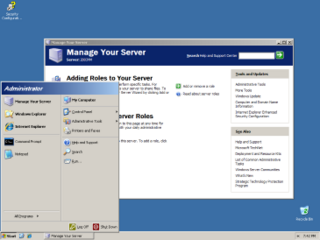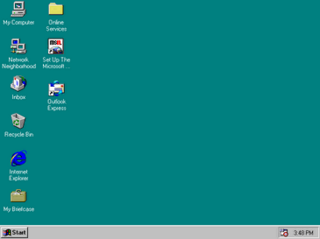
Windows 95 is a consumer-oriented operating system developed by Microsoft as part of its Windows 9x family of operating systems. The first operating system in the 9x family, it is the successor to Windows 3.1x, and was released to manufacturing on August 15, 1995, and generally to retail on August 24, 1995. Windows 95 merged Microsoft's formerly separate MS-DOS and Windows products, and featured significant improvements over its predecessor, most notably in the graphical user interface (GUI) and in its simplified "plug-and-play" features. There were also major changes made to the core components of the operating system, such as moving from a mainly co-operatively multitasked 16-bit architecture to a 32-bit preemptive multitasking architecture.

Windows 98 is a graphical operating system developed by Microsoft as part of its Windows 9x family of operating systems. It is the successor to Windows 95, and was released to manufacturing on May 15, 1998, and to retail on June 25, 1998. Like its predecessor, Windows 98 is a hybrid 16-bit and 32-bit monolithic product with the boot stage based on MS-DOS. The startup sound for Windows 98 was composed by Microsoft sound engineer Ken Kato, who considered it to be a "tough act to follow".

Windows Server 2003 is a server operating system produced by Microsoft and released on April 24, 2003. It is the successor to Windows 2000 Server and the predecessor to Windows Server 2008. An updated version, Windows Server 2003 R2, was released to manufacturing on December 6, 2005. Windows Server 2003's kernel was later adopted in the development of Windows Vista.
NTLDR is the boot loader for all releases of Windows NT operating system up to and including Windows XP and Windows Server 2003. NTLDR is typically run from the primary hard disk drive, but it can also run from portable storage devices such as a CD-ROM, USB flash drive, or floppy disk. NTLDR can also load a non NT-based operating system given the appropriate boot sector in a file.

Windows 9x is a generic term referring to a series of Microsoft Windows computer operating systems produced from 1995 to 2000, which were based on the Windows 95 kernel and its underlying foundation of MS-DOS, both of which were updated in subsequent versions. This includes all versions of Windows 95 and Windows 98. Windows ME is sometimes included.
AUTOEXEC.BAT is a system file that was originally on DOS-type operating systems. It is a plain-text batch file in the root directory of the boot device. The name of the file is an abbreviation of "automatic execution", which describes its function in automatically executing commands on system startup; the filename was coined in response to the 8.3 filename limitations of the FAT file system family.

Program Manager is the shell of Windows 3.x and Windows NT 3.x operating systems. This shell exposed a task-oriented graphical user interface (GUI), consisting of icons arranged into program groups. It replaced MS-DOS Executive, a file manager, as the default Windows shell.

The Windows Registry is a hierarchical database that stores low-level settings for the Microsoft Windows operating system and for applications that opt to use the registry. The kernel, device drivers, services, Security Accounts Manager, and user interface can all use the registry. The registry also allows access to counters for profiling system performance.
The Global Assembly Cache (GAC) is a machine-wide CLI assembly cache for the Common Language Infrastructure (CLI) in Microsoft's .NET Framework. The approach of having a specially controlled central repository addresses the flaws in the shared library concept and helps to avoid pitfalls of other solutions that led to drawbacks like DLL hell.
Safe mode is a diagnostic mode of a computer operating system (OS). It can also refer to a mode of operation by application software. In Windows, safe mode only allows essential system programs and services to start up at boot. Safe mode is intended to help fix most, if not all problems within an operating system. It is also widely used for removing rogue security software.
The INI file format is an informal standard for configuration files for some computing platforms or software. INI files are simple text files with a basic structure composed of sections, properties, and values.

System Restore is a feature in Microsoft Windows that allows the user to revert their computer's state to that of a previous point in time, which can be used to recover from system malfunctions or other problems. First included in Windows ME, it has been included in all following desktop versions of Windows released since, excluding the Windows Server. In Windows 10, System Restore is turned off by default and must be enabled by users in order to function. This does not affect personal files such as documents, music, pictures, and videos.
The Windows NT startup process is the process by which Windows NT 4.0, Windows 2000, Windows XP and Windows Server 2003 operating systems initialize. In Windows Vista and later, this process has changed significantly; see Windows Vista startup process for information about what has changed.
ntoskrnl.exe, also known as kernel image, provides the kernel and executive layers of the Windows NT kernel space, and is responsible for various system services such as hardware abstraction, process and memory management, thus making it a fundamental part of the system. It contains the cache manager, the executive, the kernel, the security reference monitor, the memory manager, and the scheduler (Dispatcher).

MSConfig is a system utility to troubleshoot the Microsoft Windows startup process. It can disable or re-enable software, device drivers and Windows services that run at startup, or change boot parameters.
WIN.INI is a basic INI file that was used in versions of the Microsoft Windows operating environment up to Windows 3.11 to store basic settings at boot time. By default, all font, communications drivers, wallpaper, screen saver, and language settings were stored in WIN.INI by Windows 3.x. Many of these settings were honored in Windows 9x, although the files had begun to be phased out in favor of the Windows registry. Windows XP still acknowledged some entries in the WIN.INI file to provide backwards compatibility with older 16-bit applications. However, when a fresh install of XP is performed, the WIN.INI file created is initially blank, and in Windows Vista and Windows 7 the WIN.INI file was removed entirely.
SYSTEM.INI was an initialization used in early versions of Microsoft Windows to load device drivers and the default Windows shell, among other system settings. Many of these settings were honored in Windows 9x, although the INI files had begun to be phased out in favor of the Windows Registry. Windows NT 4.0, 2000, XP and Server 2003 still acknowledge some SYSTEM.INI entries in order to provide backwards compatibility with older 16-bit applications. Windows Vista and beyond also have SYSTEM.INI as well. However, when a fresh install of XP/Server 2003 is performed, the SYSTEM.INI file created contains by default only these lines:
The Windows startup process is the process by which Microsoft's Windows series of operating systems initializes.
Microsoft Application Virtualization is an application virtualization and application streaming solution from Microsoft. It was originally developed by Softricity, a company based in Boston, Massachusetts, acquired by Microsoft on July 17, 2006. App-V represents Microsoft's entry to the application virtualization market, alongside their other virtualization technologies such as Hyper-V, Microsoft User Environment Virtualization (UE-V), Remote Desktop Services, and System Center Virtual Machine Manager.

The architecture of the Windows 9x series kernel is monolithic. The basic code is considered similar in function to MS-DOS. As a 16-/32-bit hybrid, it requires MS-DOS support to operate.










